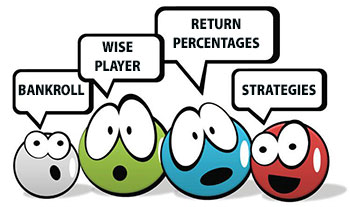BEST STRATEGIES FOR SLOTS
Even with slots, a little strategy goes a long way
By Frank Scoblete
 Even though the house has an edge on just about every slot machine and video poker game (with some few, hard-to-find exceptions), players can still play a tough game against the casino if such players use intelligent strategies in deciding which games to play and how to play them.
Even though the house has an edge on just about every slot machine and video poker game (with some few, hard-to-find exceptions), players can still play a tough game against the casino if such players use intelligent strategies in deciding which games to play and how to play them.
Pessimists might say that all slot and video poker players are doomed to forfeit their money to the house edge, and they are right, except that how you forfeit the game against the house is where the gambling pleasure comes into the picture. In short, don’t just give the casino your money by playing the worst games with the worst strategies. Instead, play games where the contest is close to even or at the very least as even as you can get. Give the casino a real run for your money.
So let’s take a look at slot machines to outline some general rules to follow if you want to play the strongest possible game against the casino.
Analyze the slot return percentages in this magazine and you can see clearly that not all denominations return the same percentages. Right o the bat, this tells you something important; not all slot machines are the same. Some are better for your bankroll; some are worse. The smart player picks the better machines to play. Do most slot players know to do this? No.
Slot returns by denomination are not the only story. Within denominations the returns of different types of machines vary. Let us say that you have a traditional one-dollar machine and you decide to play one that has a progressive jackpot or a progressive jackpot that is linked with other casinos, you should know that the return percentage is often far less because those big progressive jackpots must be paid for sooner or later by the casino. Because of that the machine will hold a greater percentage of the money you put in.
Take Megabucks as a specific example. The odds of hitting the “big one” are just about 50 million to one. The return percentage of the machine is usually around 86 percent. You are facing a big house edge on such a machine.
Now take a look at a stand-alone non-progressive machine and you will see the difference in returns. If you follow the percentages of one-dollar returns, you know that they are averaging in the 90-92 percent range across the country. So the 86 percent return of a linked progressive such as Megabucks is made up for by the larger return of non-progressive machines. So which machines give you the greater chance of being ahead on any given day? Obviously the non-progressives; they could be coming in with returns in the 95 or higher percentages. Take that to heart.
So the wise advice is to play a non-progressive machine if you want a better chance of coming home with some money. I admit that those huge progressives are fantasy machines but, sadly, most of our fantasies in life do not come true.
I tend to differ with many slot-machine writers in an important area. On those non-progressive machines, it makes no sense to play full coin in order to have a chance at the top jackpot which is, I admit, larger using full coin. The increase in that jackpot is not worth the extra risk. These jackpots only increase the return on the machine by a fraction of a percent; yet you are betting quite a bit more in money to get only a fraction of a better return. The cost is a waste of money in these cases.
To be specific, if you play, say three coins, you aren’t getting three times the value. You are getting a fractionally higher return but spending three times to play the game.
Think of spending a night playing three coins spin after spin after spin—how much money are you putting into the casinos’ craw doing that? On a three-coin traditional machine, playing one coin over four or five hours cuts your risk significantly compared to playing three coins per spin. That’s a big savings over time.
In today’s new-fangled slot world, there are many types of machines and payouts all over the landscape. Traditional machines now compete with fabulous video machines, multi-play machines, multi-coin machines, multi denomination machines and the like. How should a wise slot player approach these machines? Are there better or worse ways to play?
Of course, of course!
The question most asked of me is simple: Do penny machines and nickel machines return good percentages if I play, say, twenty lines (give or take)? In fact, they don’t. A nickel machine pays a nickel’s return and the more money you dump in the more those larger nickel percentages eat at your bankroll. Don’t waste your money. If those nickels add up to (let us say) a quarter, you are playing a quarter machine; if they add up to a dollar, you are playing a dollar machine but you aren’t getting a quarter machine or a dollar machine’s return.
If you want to put in enough nickels that they add up to a dollar (or a quarter) you are much, much better off just moving to a dollar or quarter machine.
[Read Frank Scoblete’s books I Am a Card Counter: Inside the World of Advantage-Play Blackjack, I Am a Dice Controller: Inside the World of Advantage-Play Craps and Confessions of a Wayward Catholic!All available from Amazon.com, on Kindle and electronic media, at Barnes and Noble, and at bookstores. Visit Frank’s web site at www.frankscoblete.com]


